Project Management on Happiness: An Annotated Bibliography and Critical Analysis
VerifiedAdded on 2023/06/03
|15
|4970
|125
AI Summary
This scholarly research sheds light on the factors that add happiness into the lives of individuals. The article includes an annotated bibliography and critical analysis of suggested articles, along with a timeline of activities and implementation of planned activities. The subject is project management, and the course code, name, and university are not mentioned.
Contribute Materials
Your contribution can guide someone’s learning journey. Share your
documents today.
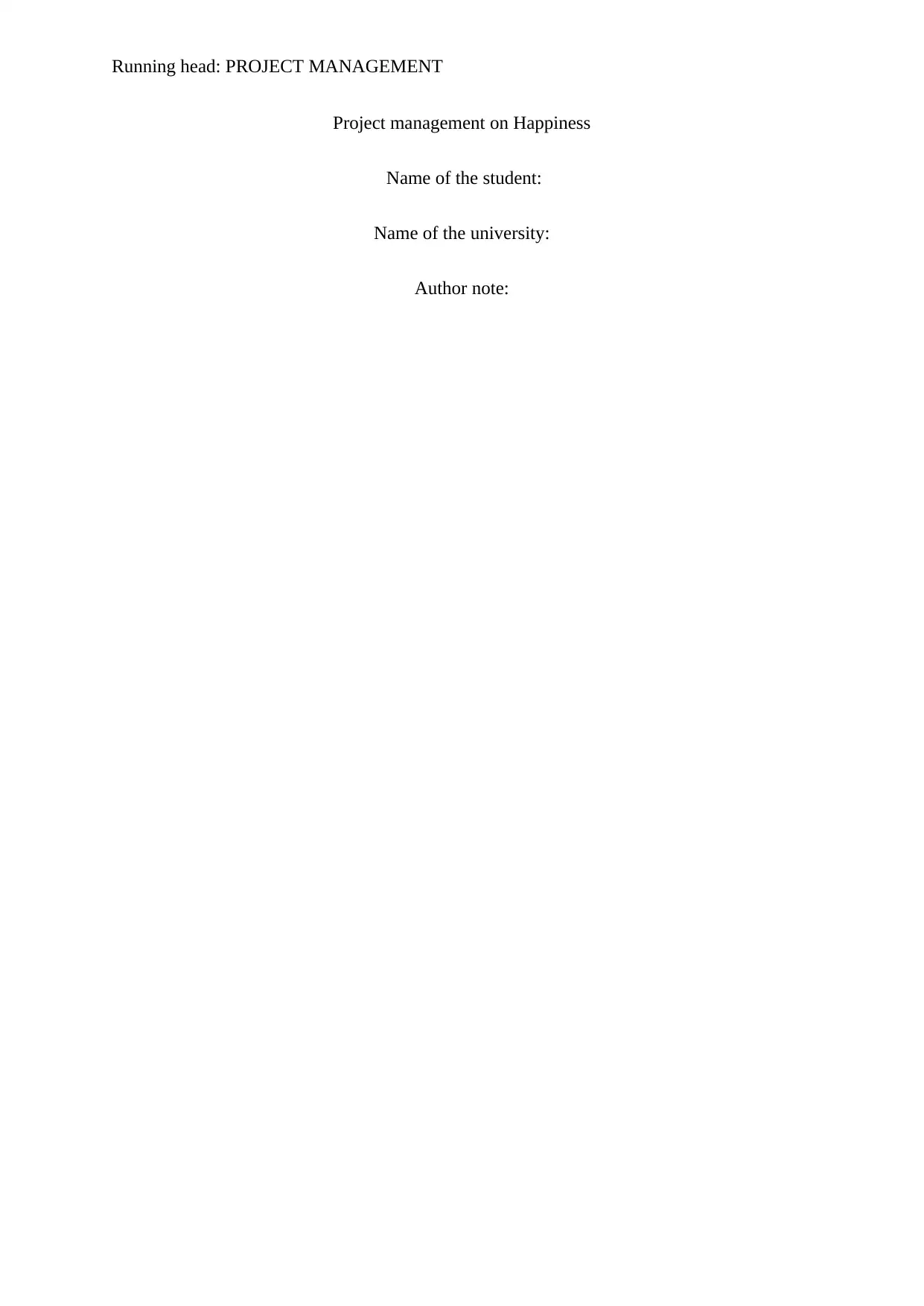
Running head: PROJECT MANAGEMENT
Project management on Happiness
Name of the student:
Name of the university:
Author note:
Project management on Happiness
Name of the student:
Name of the university:
Author note:
Secure Best Marks with AI Grader
Need help grading? Try our AI Grader for instant feedback on your assignments.
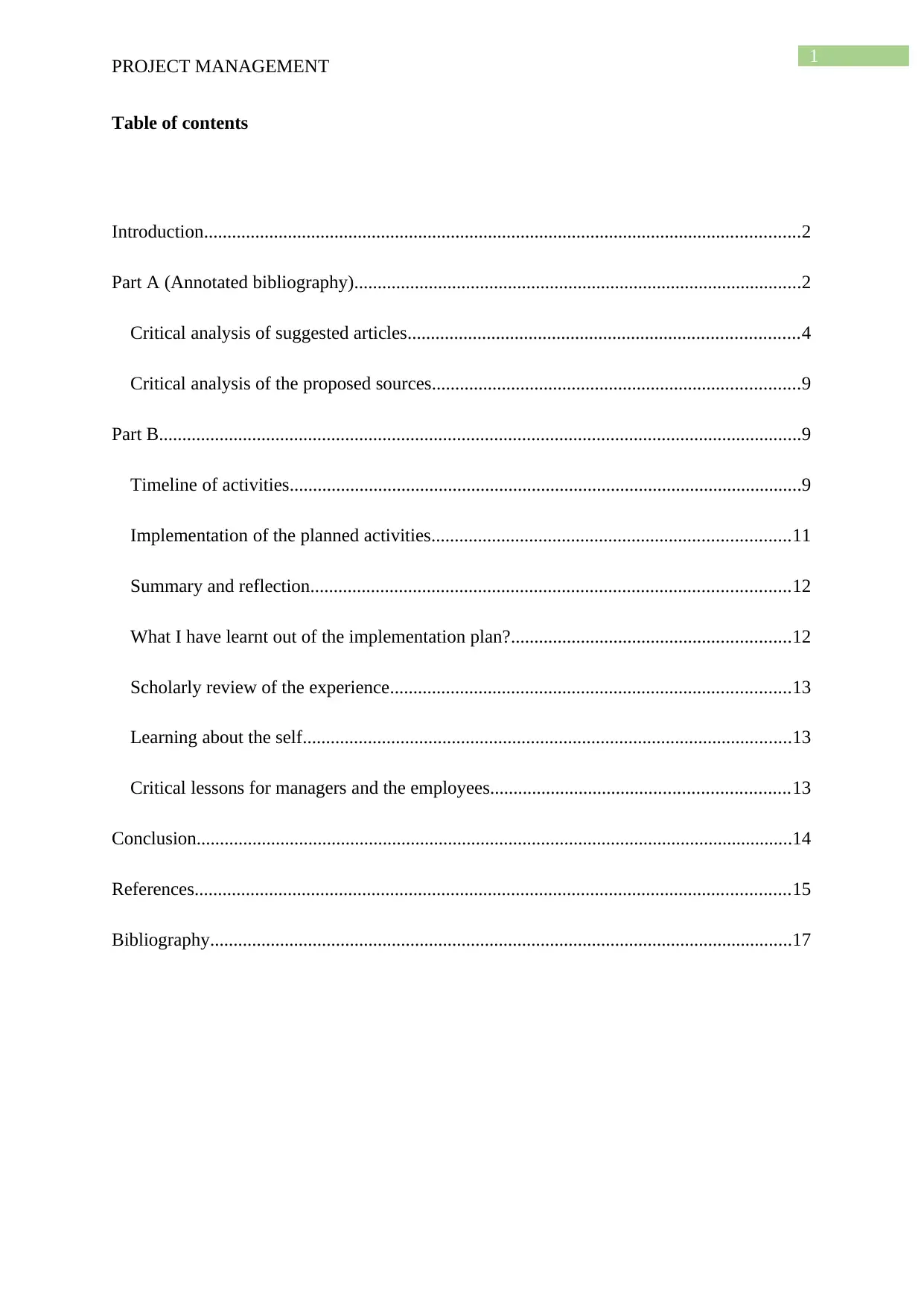
1
PROJECT MANAGEMENT
Table of contents
Introduction................................................................................................................................2
Part A (Annotated bibliography)................................................................................................2
Critical analysis of suggested articles....................................................................................4
Critical analysis of the proposed sources...............................................................................9
Part B..........................................................................................................................................9
Timeline of activities..............................................................................................................9
Implementation of the planned activities.............................................................................11
Summary and reflection.......................................................................................................12
What I have learnt out of the implementation plan?............................................................12
Scholarly review of the experience......................................................................................13
Learning about the self.........................................................................................................13
Critical lessons for managers and the employees................................................................13
Conclusion................................................................................................................................14
References................................................................................................................................15
Bibliography.............................................................................................................................17
PROJECT MANAGEMENT
Table of contents
Introduction................................................................................................................................2
Part A (Annotated bibliography)................................................................................................2
Critical analysis of suggested articles....................................................................................4
Critical analysis of the proposed sources...............................................................................9
Part B..........................................................................................................................................9
Timeline of activities..............................................................................................................9
Implementation of the planned activities.............................................................................11
Summary and reflection.......................................................................................................12
What I have learnt out of the implementation plan?............................................................12
Scholarly review of the experience......................................................................................13
Learning about the self.........................................................................................................13
Critical lessons for managers and the employees................................................................13
Conclusion................................................................................................................................14
References................................................................................................................................15
Bibliography.............................................................................................................................17
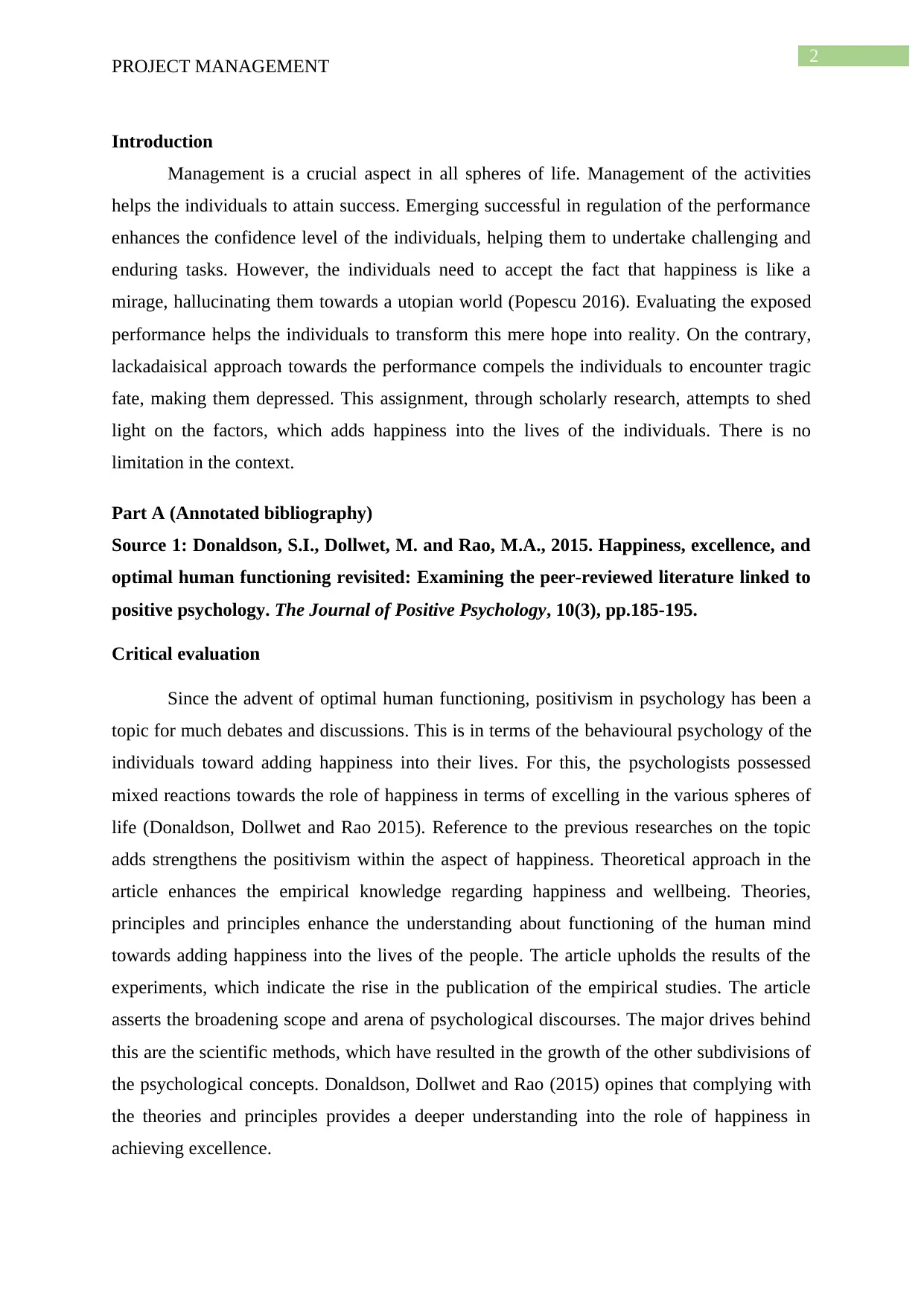
2
PROJECT MANAGEMENT
Introduction
Management is a crucial aspect in all spheres of life. Management of the activities
helps the individuals to attain success. Emerging successful in regulation of the performance
enhances the confidence level of the individuals, helping them to undertake challenging and
enduring tasks. However, the individuals need to accept the fact that happiness is like a
mirage, hallucinating them towards a utopian world (Popescu 2016). Evaluating the exposed
performance helps the individuals to transform this mere hope into reality. On the contrary,
lackadaisical approach towards the performance compels the individuals to encounter tragic
fate, making them depressed. This assignment, through scholarly research, attempts to shed
light on the factors, which adds happiness into the lives of the individuals. There is no
limitation in the context.
Part A (Annotated bibliography)
Source 1: Donaldson, S.I., Dollwet, M. and Rao, M.A., 2015. Happiness, excellence, and
optimal human functioning revisited: Examining the peer-reviewed literature linked to
positive psychology. The Journal of Positive Psychology, 10(3), pp.185-195.
Critical evaluation
Since the advent of optimal human functioning, positivism in psychology has been a
topic for much debates and discussions. This is in terms of the behavioural psychology of the
individuals toward adding happiness into their lives. For this, the psychologists possessed
mixed reactions towards the role of happiness in terms of excelling in the various spheres of
life (Donaldson, Dollwet and Rao 2015). Reference to the previous researches on the topic
adds strengthens the positivism within the aspect of happiness. Theoretical approach in the
article enhances the empirical knowledge regarding happiness and wellbeing. Theories,
principles and principles enhance the understanding about functioning of the human mind
towards adding happiness into the lives of the people. The article upholds the results of the
experiments, which indicate the rise in the publication of the empirical studies. The article
asserts the broadening scope and arena of psychological discourses. The major drives behind
this are the scientific methods, which have resulted in the growth of the other subdivisions of
the psychological concepts. Donaldson, Dollwet and Rao (2015) opines that complying with
the theories and principles provides a deeper understanding into the role of happiness in
achieving excellence.
PROJECT MANAGEMENT
Introduction
Management is a crucial aspect in all spheres of life. Management of the activities
helps the individuals to attain success. Emerging successful in regulation of the performance
enhances the confidence level of the individuals, helping them to undertake challenging and
enduring tasks. However, the individuals need to accept the fact that happiness is like a
mirage, hallucinating them towards a utopian world (Popescu 2016). Evaluating the exposed
performance helps the individuals to transform this mere hope into reality. On the contrary,
lackadaisical approach towards the performance compels the individuals to encounter tragic
fate, making them depressed. This assignment, through scholarly research, attempts to shed
light on the factors, which adds happiness into the lives of the individuals. There is no
limitation in the context.
Part A (Annotated bibliography)
Source 1: Donaldson, S.I., Dollwet, M. and Rao, M.A., 2015. Happiness, excellence, and
optimal human functioning revisited: Examining the peer-reviewed literature linked to
positive psychology. The Journal of Positive Psychology, 10(3), pp.185-195.
Critical evaluation
Since the advent of optimal human functioning, positivism in psychology has been a
topic for much debates and discussions. This is in terms of the behavioural psychology of the
individuals toward adding happiness into their lives. For this, the psychologists possessed
mixed reactions towards the role of happiness in terms of excelling in the various spheres of
life (Donaldson, Dollwet and Rao 2015). Reference to the previous researches on the topic
adds strengthens the positivism within the aspect of happiness. Theoretical approach in the
article enhances the empirical knowledge regarding happiness and wellbeing. Theories,
principles and principles enhance the understanding about functioning of the human mind
towards adding happiness into the lives of the people. The article upholds the results of the
experiments, which indicate the rise in the publication of the empirical studies. The article
asserts the broadening scope and arena of psychological discourses. The major drives behind
this are the scientific methods, which have resulted in the growth of the other subdivisions of
the psychological concepts. Donaldson, Dollwet and Rao (2015) opines that complying with
the theories and principles provides a deeper understanding into the role of happiness in
achieving excellence.
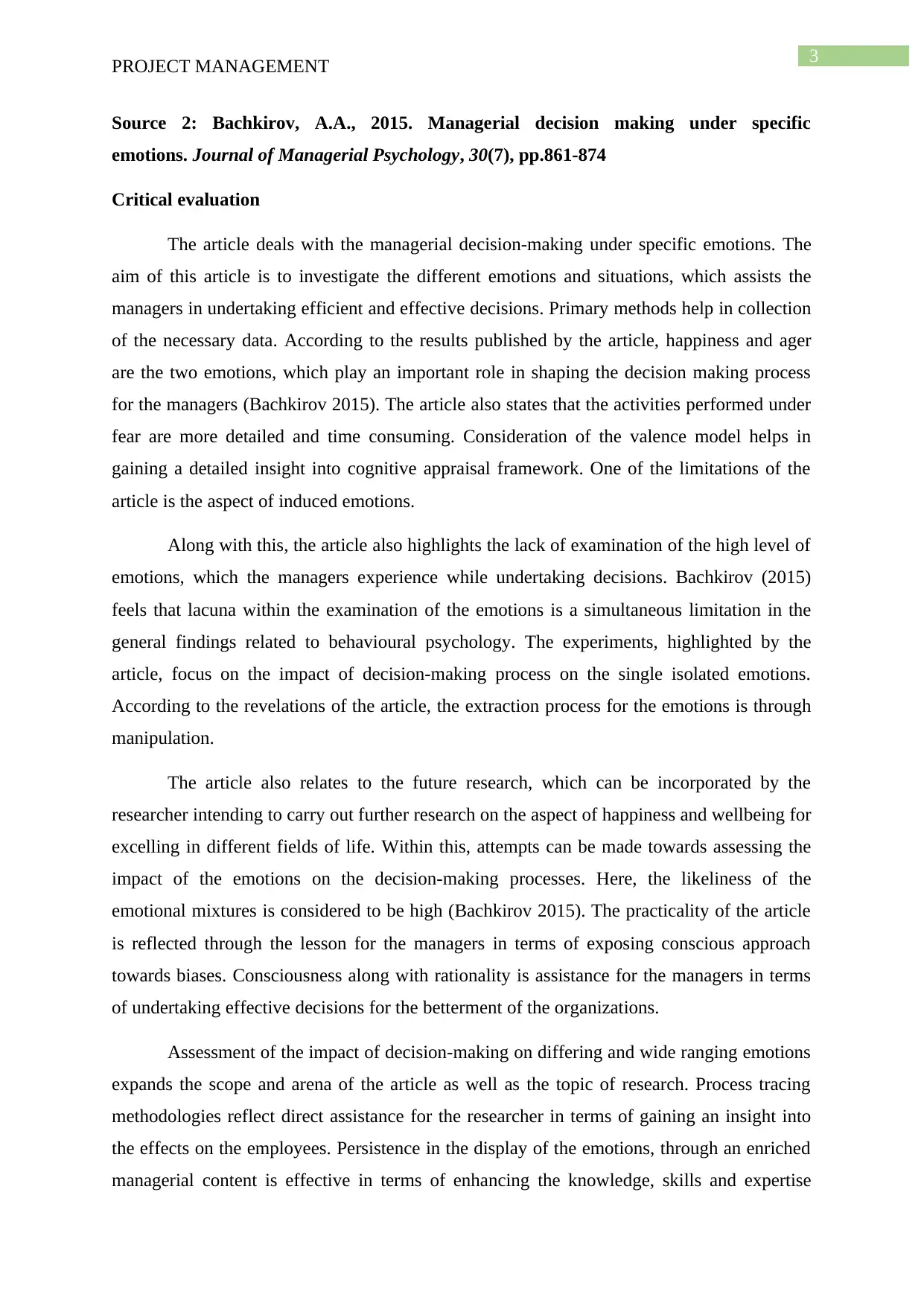
3
PROJECT MANAGEMENT
Source 2: Bachkirov, A.A., 2015. Managerial decision making under specific
emotions. Journal of Managerial Psychology, 30(7), pp.861-874
Critical evaluation
The article deals with the managerial decision-making under specific emotions. The
aim of this article is to investigate the different emotions and situations, which assists the
managers in undertaking efficient and effective decisions. Primary methods help in collection
of the necessary data. According to the results published by the article, happiness and ager
are the two emotions, which play an important role in shaping the decision making process
for the managers (Bachkirov 2015). The article also states that the activities performed under
fear are more detailed and time consuming. Consideration of the valence model helps in
gaining a detailed insight into cognitive appraisal framework. One of the limitations of the
article is the aspect of induced emotions.
Along with this, the article also highlights the lack of examination of the high level of
emotions, which the managers experience while undertaking decisions. Bachkirov (2015)
feels that lacuna within the examination of the emotions is a simultaneous limitation in the
general findings related to behavioural psychology. The experiments, highlighted by the
article, focus on the impact of decision-making process on the single isolated emotions.
According to the revelations of the article, the extraction process for the emotions is through
manipulation.
The article also relates to the future research, which can be incorporated by the
researcher intending to carry out further research on the aspect of happiness and wellbeing for
excelling in different fields of life. Within this, attempts can be made towards assessing the
impact of the emotions on the decision-making processes. Here, the likeliness of the
emotional mixtures is considered to be high (Bachkirov 2015). The practicality of the article
is reflected through the lesson for the managers in terms of exposing conscious approach
towards biases. Consciousness along with rationality is assistance for the managers in terms
of undertaking effective decisions for the betterment of the organizations.
Assessment of the impact of decision-making on differing and wide ranging emotions
expands the scope and arena of the article as well as the topic of research. Process tracing
methodologies reflect direct assistance for the researcher in terms of gaining an insight into
the effects on the employees. Persistence in the display of the emotions, through an enriched
managerial content is effective in terms of enhancing the knowledge, skills and expertise
PROJECT MANAGEMENT
Source 2: Bachkirov, A.A., 2015. Managerial decision making under specific
emotions. Journal of Managerial Psychology, 30(7), pp.861-874
Critical evaluation
The article deals with the managerial decision-making under specific emotions. The
aim of this article is to investigate the different emotions and situations, which assists the
managers in undertaking efficient and effective decisions. Primary methods help in collection
of the necessary data. According to the results published by the article, happiness and ager
are the two emotions, which play an important role in shaping the decision making process
for the managers (Bachkirov 2015). The article also states that the activities performed under
fear are more detailed and time consuming. Consideration of the valence model helps in
gaining a detailed insight into cognitive appraisal framework. One of the limitations of the
article is the aspect of induced emotions.
Along with this, the article also highlights the lack of examination of the high level of
emotions, which the managers experience while undertaking decisions. Bachkirov (2015)
feels that lacuna within the examination of the emotions is a simultaneous limitation in the
general findings related to behavioural psychology. The experiments, highlighted by the
article, focus on the impact of decision-making process on the single isolated emotions.
According to the revelations of the article, the extraction process for the emotions is through
manipulation.
The article also relates to the future research, which can be incorporated by the
researcher intending to carry out further research on the aspect of happiness and wellbeing for
excelling in different fields of life. Within this, attempts can be made towards assessing the
impact of the emotions on the decision-making processes. Here, the likeliness of the
emotional mixtures is considered to be high (Bachkirov 2015). The practicality of the article
is reflected through the lesson for the managers in terms of exposing conscious approach
towards biases. Consciousness along with rationality is assistance for the managers in terms
of undertaking effective decisions for the betterment of the organizations.
Assessment of the impact of decision-making on differing and wide ranging emotions
expands the scope and arena of the article as well as the topic of research. Process tracing
methodologies reflect direct assistance for the researcher in terms of gaining an insight into
the effects on the employees. Persistence in the display of the emotions, through an enriched
managerial content is effective in terms of enhancing the knowledge, skills and expertise
Secure Best Marks with AI Grader
Need help grading? Try our AI Grader for instant feedback on your assignments.
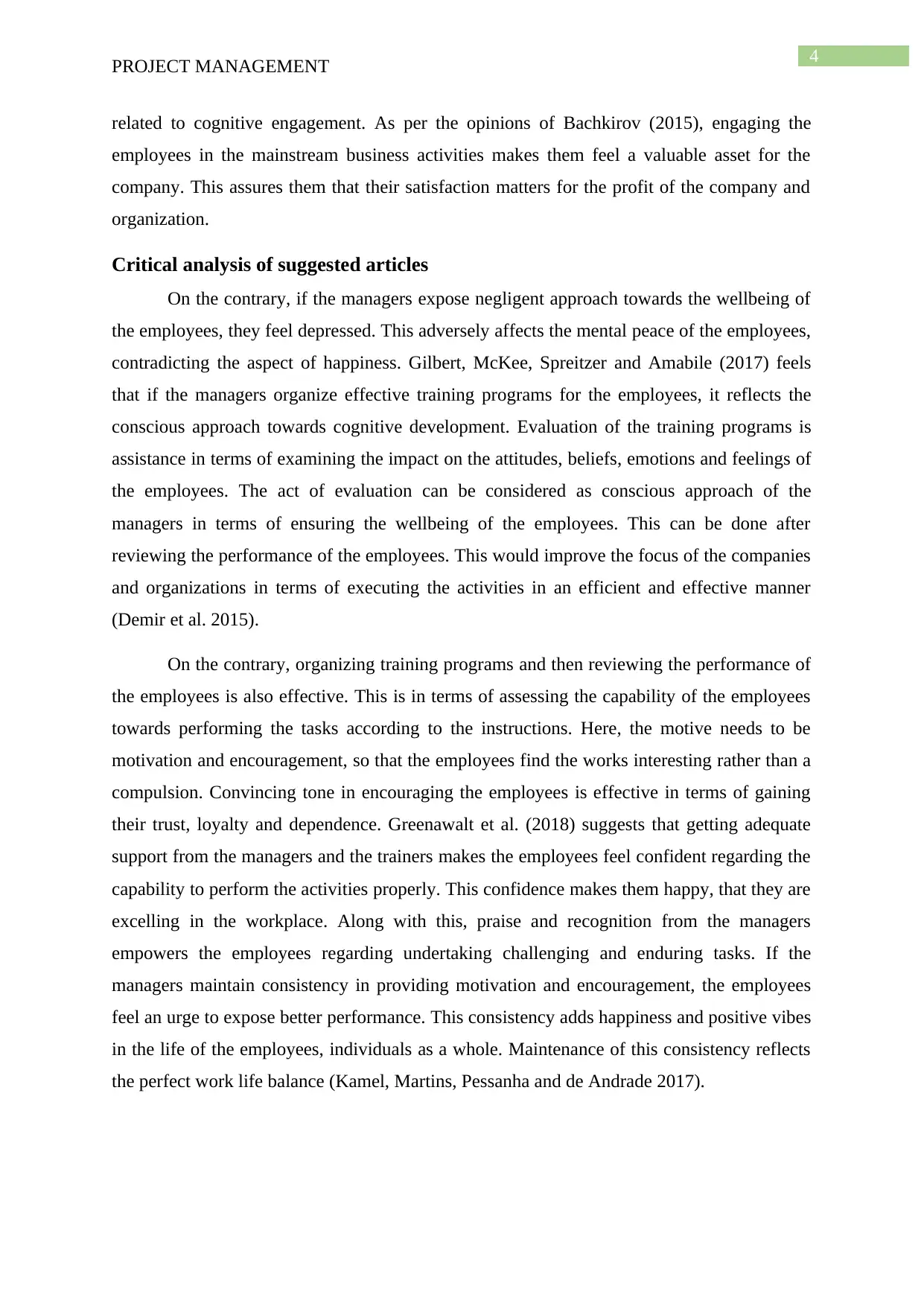
4
PROJECT MANAGEMENT
related to cognitive engagement. As per the opinions of Bachkirov (2015), engaging the
employees in the mainstream business activities makes them feel a valuable asset for the
company. This assures them that their satisfaction matters for the profit of the company and
organization.
Critical analysis of suggested articles
On the contrary, if the managers expose negligent approach towards the wellbeing of
the employees, they feel depressed. This adversely affects the mental peace of the employees,
contradicting the aspect of happiness. Gilbert, McKee, Spreitzer and Amabile (2017) feels
that if the managers organize effective training programs for the employees, it reflects the
conscious approach towards cognitive development. Evaluation of the training programs is
assistance in terms of examining the impact on the attitudes, beliefs, emotions and feelings of
the employees. The act of evaluation can be considered as conscious approach of the
managers in terms of ensuring the wellbeing of the employees. This can be done after
reviewing the performance of the employees. This would improve the focus of the companies
and organizations in terms of executing the activities in an efficient and effective manner
(Demir et al. 2015).
On the contrary, organizing training programs and then reviewing the performance of
the employees is also effective. This is in terms of assessing the capability of the employees
towards performing the tasks according to the instructions. Here, the motive needs to be
motivation and encouragement, so that the employees find the works interesting rather than a
compulsion. Convincing tone in encouraging the employees is effective in terms of gaining
their trust, loyalty and dependence. Greenawalt et al. (2018) suggests that getting adequate
support from the managers and the trainers makes the employees feel confident regarding the
capability to perform the activities properly. This confidence makes them happy, that they are
excelling in the workplace. Along with this, praise and recognition from the managers
empowers the employees regarding undertaking challenging and enduring tasks. If the
managers maintain consistency in providing motivation and encouragement, the employees
feel an urge to expose better performance. This consistency adds happiness and positive vibes
in the life of the employees, individuals as a whole. Maintenance of this consistency reflects
the perfect work life balance (Kamel, Martins, Pessanha and de Andrade 2017).
PROJECT MANAGEMENT
related to cognitive engagement. As per the opinions of Bachkirov (2015), engaging the
employees in the mainstream business activities makes them feel a valuable asset for the
company. This assures them that their satisfaction matters for the profit of the company and
organization.
Critical analysis of suggested articles
On the contrary, if the managers expose negligent approach towards the wellbeing of
the employees, they feel depressed. This adversely affects the mental peace of the employees,
contradicting the aspect of happiness. Gilbert, McKee, Spreitzer and Amabile (2017) feels
that if the managers organize effective training programs for the employees, it reflects the
conscious approach towards cognitive development. Evaluation of the training programs is
assistance in terms of examining the impact on the attitudes, beliefs, emotions and feelings of
the employees. The act of evaluation can be considered as conscious approach of the
managers in terms of ensuring the wellbeing of the employees. This can be done after
reviewing the performance of the employees. This would improve the focus of the companies
and organizations in terms of executing the activities in an efficient and effective manner
(Demir et al. 2015).
On the contrary, organizing training programs and then reviewing the performance of
the employees is also effective. This is in terms of assessing the capability of the employees
towards performing the tasks according to the instructions. Here, the motive needs to be
motivation and encouragement, so that the employees find the works interesting rather than a
compulsion. Convincing tone in encouraging the employees is effective in terms of gaining
their trust, loyalty and dependence. Greenawalt et al. (2018) suggests that getting adequate
support from the managers and the trainers makes the employees feel confident regarding the
capability to perform the activities properly. This confidence makes them happy, that they are
excelling in the workplace. Along with this, praise and recognition from the managers
empowers the employees regarding undertaking challenging and enduring tasks. If the
managers maintain consistency in providing motivation and encouragement, the employees
feel an urge to expose better performance. This consistency adds happiness and positive vibes
in the life of the employees, individuals as a whole. Maintenance of this consistency reflects
the perfect work life balance (Kamel, Martins, Pessanha and de Andrade 2017).
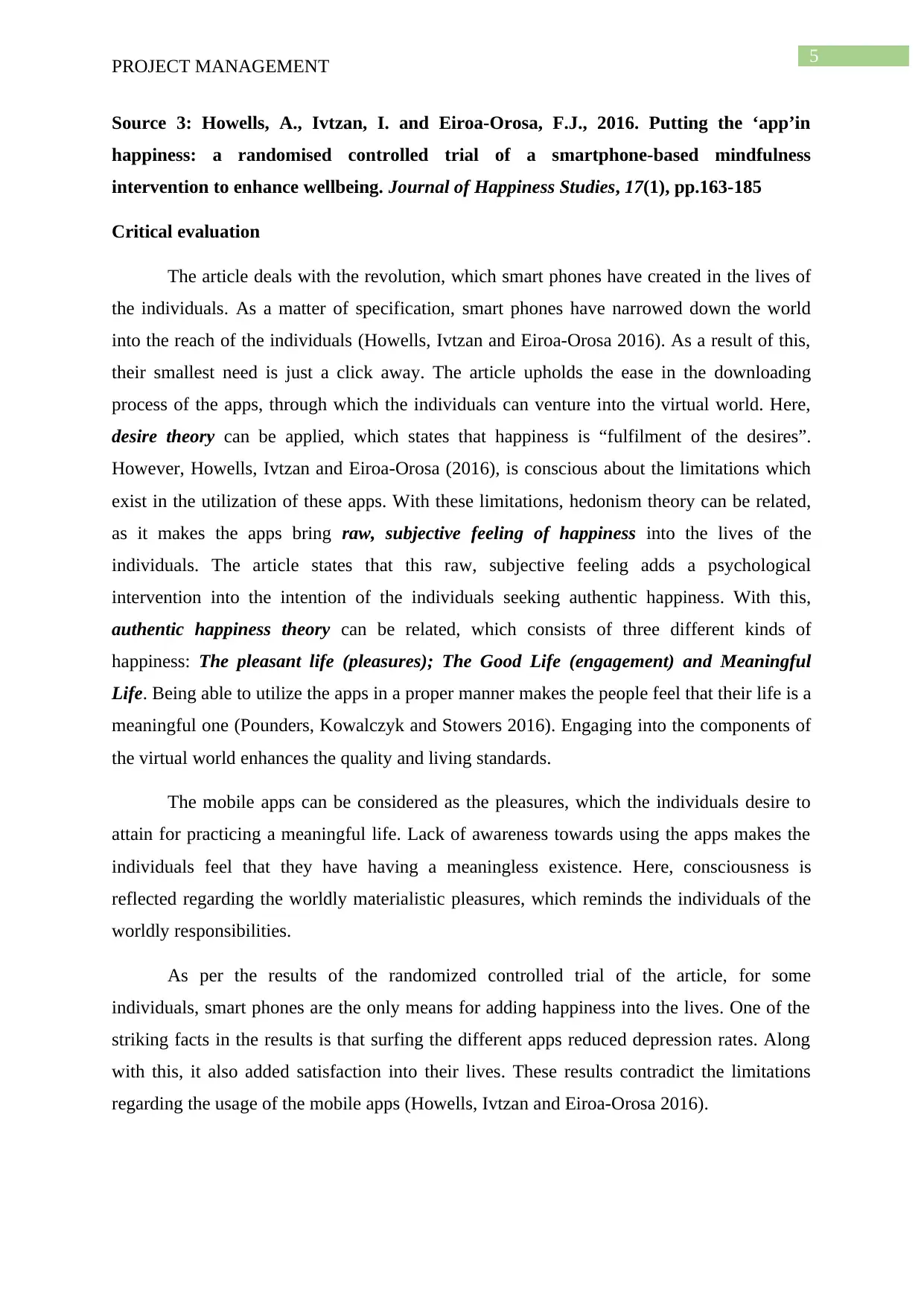
5
PROJECT MANAGEMENT
Source 3: Howells, A., Ivtzan, I. and Eiroa-Orosa, F.J., 2016. Putting the ‘app’in
happiness: a randomised controlled trial of a smartphone-based mindfulness
intervention to enhance wellbeing. Journal of Happiness Studies, 17(1), pp.163-185
Critical evaluation
The article deals with the revolution, which smart phones have created in the lives of
the individuals. As a matter of specification, smart phones have narrowed down the world
into the reach of the individuals (Howells, Ivtzan and Eiroa-Orosa 2016). As a result of this,
their smallest need is just a click away. The article upholds the ease in the downloading
process of the apps, through which the individuals can venture into the virtual world. Here,
desire theory can be applied, which states that happiness is “fulfilment of the desires”.
However, Howells, Ivtzan and Eiroa-Orosa (2016), is conscious about the limitations which
exist in the utilization of these apps. With these limitations, hedonism theory can be related,
as it makes the apps bring raw, subjective feeling of happiness into the lives of the
individuals. The article states that this raw, subjective feeling adds a psychological
intervention into the intention of the individuals seeking authentic happiness. With this,
authentic happiness theory can be related, which consists of three different kinds of
happiness: The pleasant life (pleasures); The Good Life (engagement) and Meaningful
Life. Being able to utilize the apps in a proper manner makes the people feel that their life is a
meaningful one (Pounders, Kowalczyk and Stowers 2016). Engaging into the components of
the virtual world enhances the quality and living standards.
The mobile apps can be considered as the pleasures, which the individuals desire to
attain for practicing a meaningful life. Lack of awareness towards using the apps makes the
individuals feel that they have having a meaningless existence. Here, consciousness is
reflected regarding the worldly materialistic pleasures, which reminds the individuals of the
worldly responsibilities.
As per the results of the randomized controlled trial of the article, for some
individuals, smart phones are the only means for adding happiness into the lives. One of the
striking facts in the results is that surfing the different apps reduced depression rates. Along
with this, it also added satisfaction into their lives. These results contradict the limitations
regarding the usage of the mobile apps (Howells, Ivtzan and Eiroa-Orosa 2016).
PROJECT MANAGEMENT
Source 3: Howells, A., Ivtzan, I. and Eiroa-Orosa, F.J., 2016. Putting the ‘app’in
happiness: a randomised controlled trial of a smartphone-based mindfulness
intervention to enhance wellbeing. Journal of Happiness Studies, 17(1), pp.163-185
Critical evaluation
The article deals with the revolution, which smart phones have created in the lives of
the individuals. As a matter of specification, smart phones have narrowed down the world
into the reach of the individuals (Howells, Ivtzan and Eiroa-Orosa 2016). As a result of this,
their smallest need is just a click away. The article upholds the ease in the downloading
process of the apps, through which the individuals can venture into the virtual world. Here,
desire theory can be applied, which states that happiness is “fulfilment of the desires”.
However, Howells, Ivtzan and Eiroa-Orosa (2016), is conscious about the limitations which
exist in the utilization of these apps. With these limitations, hedonism theory can be related,
as it makes the apps bring raw, subjective feeling of happiness into the lives of the
individuals. The article states that this raw, subjective feeling adds a psychological
intervention into the intention of the individuals seeking authentic happiness. With this,
authentic happiness theory can be related, which consists of three different kinds of
happiness: The pleasant life (pleasures); The Good Life (engagement) and Meaningful
Life. Being able to utilize the apps in a proper manner makes the people feel that their life is a
meaningful one (Pounders, Kowalczyk and Stowers 2016). Engaging into the components of
the virtual world enhances the quality and living standards.
The mobile apps can be considered as the pleasures, which the individuals desire to
attain for practicing a meaningful life. Lack of awareness towards using the apps makes the
individuals feel that they have having a meaningless existence. Here, consciousness is
reflected regarding the worldly materialistic pleasures, which reminds the individuals of the
worldly responsibilities.
As per the results of the randomized controlled trial of the article, for some
individuals, smart phones are the only means for adding happiness into the lives. One of the
striking facts in the results is that surfing the different apps reduced depression rates. Along
with this, it also added satisfaction into their lives. These results contradict the limitations
regarding the usage of the mobile apps (Howells, Ivtzan and Eiroa-Orosa 2016).
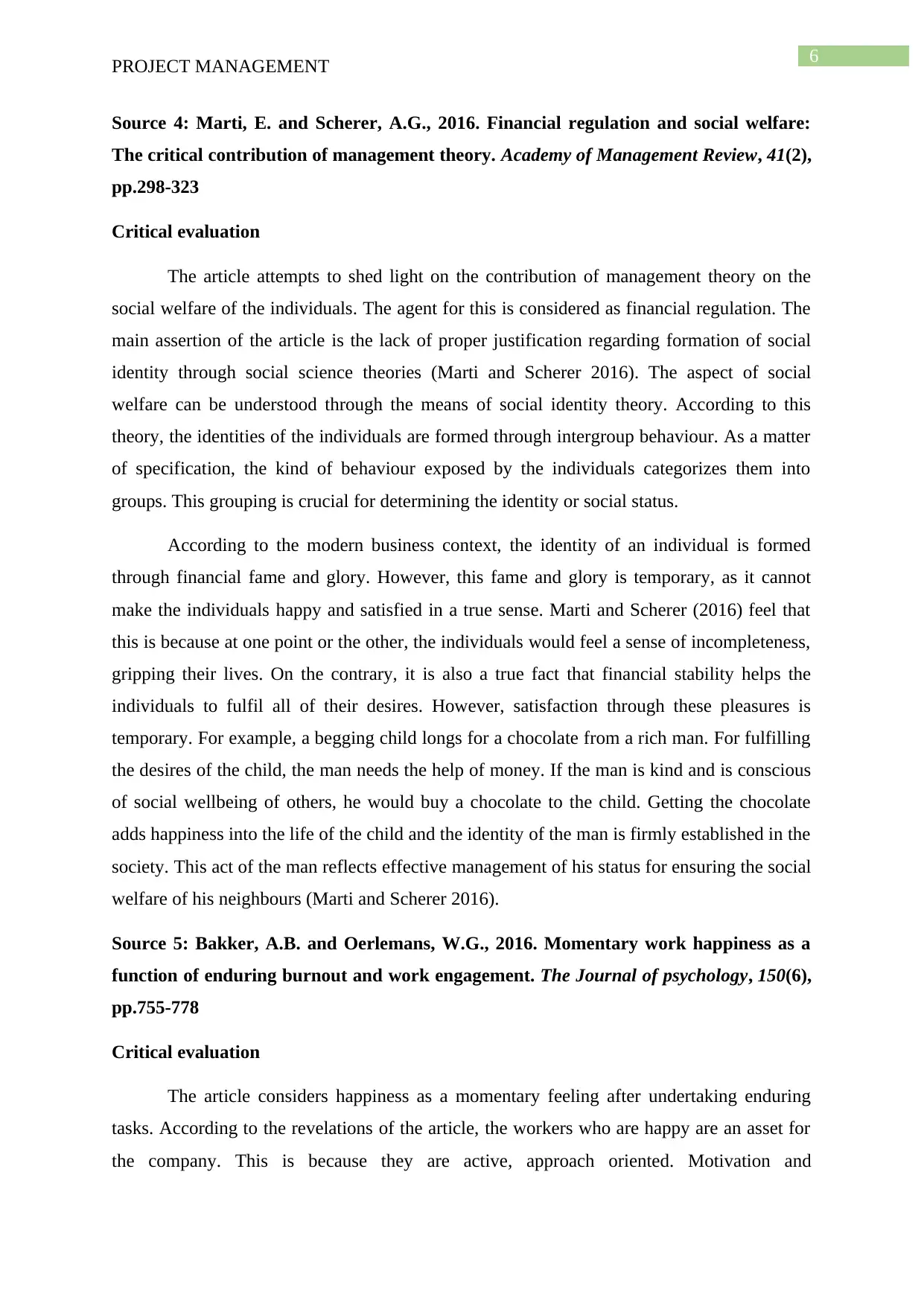
6
PROJECT MANAGEMENT
Source 4: Marti, E. and Scherer, A.G., 2016. Financial regulation and social welfare:
The critical contribution of management theory. Academy of Management Review, 41(2),
pp.298-323
Critical evaluation
The article attempts to shed light on the contribution of management theory on the
social welfare of the individuals. The agent for this is considered as financial regulation. The
main assertion of the article is the lack of proper justification regarding formation of social
identity through social science theories (Marti and Scherer 2016). The aspect of social
welfare can be understood through the means of social identity theory. According to this
theory, the identities of the individuals are formed through intergroup behaviour. As a matter
of specification, the kind of behaviour exposed by the individuals categorizes them into
groups. This grouping is crucial for determining the identity or social status.
According to the modern business context, the identity of an individual is formed
through financial fame and glory. However, this fame and glory is temporary, as it cannot
make the individuals happy and satisfied in a true sense. Marti and Scherer (2016) feel that
this is because at one point or the other, the individuals would feel a sense of incompleteness,
gripping their lives. On the contrary, it is also a true fact that financial stability helps the
individuals to fulfil all of their desires. However, satisfaction through these pleasures is
temporary. For example, a begging child longs for a chocolate from a rich man. For fulfilling
the desires of the child, the man needs the help of money. If the man is kind and is conscious
of social wellbeing of others, he would buy a chocolate to the child. Getting the chocolate
adds happiness into the life of the child and the identity of the man is firmly established in the
society. This act of the man reflects effective management of his status for ensuring the social
welfare of his neighbours (Marti and Scherer 2016).
Source 5: Bakker, A.B. and Oerlemans, W.G., 2016. Momentary work happiness as a
function of enduring burnout and work engagement. The Journal of psychology, 150(6),
pp.755-778
Critical evaluation
The article considers happiness as a momentary feeling after undertaking enduring
tasks. According to the revelations of the article, the workers who are happy are an asset for
the company. This is because they are active, approach oriented. Motivation and
PROJECT MANAGEMENT
Source 4: Marti, E. and Scherer, A.G., 2016. Financial regulation and social welfare:
The critical contribution of management theory. Academy of Management Review, 41(2),
pp.298-323
Critical evaluation
The article attempts to shed light on the contribution of management theory on the
social welfare of the individuals. The agent for this is considered as financial regulation. The
main assertion of the article is the lack of proper justification regarding formation of social
identity through social science theories (Marti and Scherer 2016). The aspect of social
welfare can be understood through the means of social identity theory. According to this
theory, the identities of the individuals are formed through intergroup behaviour. As a matter
of specification, the kind of behaviour exposed by the individuals categorizes them into
groups. This grouping is crucial for determining the identity or social status.
According to the modern business context, the identity of an individual is formed
through financial fame and glory. However, this fame and glory is temporary, as it cannot
make the individuals happy and satisfied in a true sense. Marti and Scherer (2016) feel that
this is because at one point or the other, the individuals would feel a sense of incompleteness,
gripping their lives. On the contrary, it is also a true fact that financial stability helps the
individuals to fulfil all of their desires. However, satisfaction through these pleasures is
temporary. For example, a begging child longs for a chocolate from a rich man. For fulfilling
the desires of the child, the man needs the help of money. If the man is kind and is conscious
of social wellbeing of others, he would buy a chocolate to the child. Getting the chocolate
adds happiness into the life of the child and the identity of the man is firmly established in the
society. This act of the man reflects effective management of his status for ensuring the social
welfare of his neighbours (Marti and Scherer 2016).
Source 5: Bakker, A.B. and Oerlemans, W.G., 2016. Momentary work happiness as a
function of enduring burnout and work engagement. The Journal of psychology, 150(6),
pp.755-778
Critical evaluation
The article considers happiness as a momentary feeling after undertaking enduring
tasks. According to the revelations of the article, the workers who are happy are an asset for
the company. This is because they are active, approach oriented. Motivation and
Paraphrase This Document
Need a fresh take? Get an instant paraphrase of this document with our AI Paraphraser
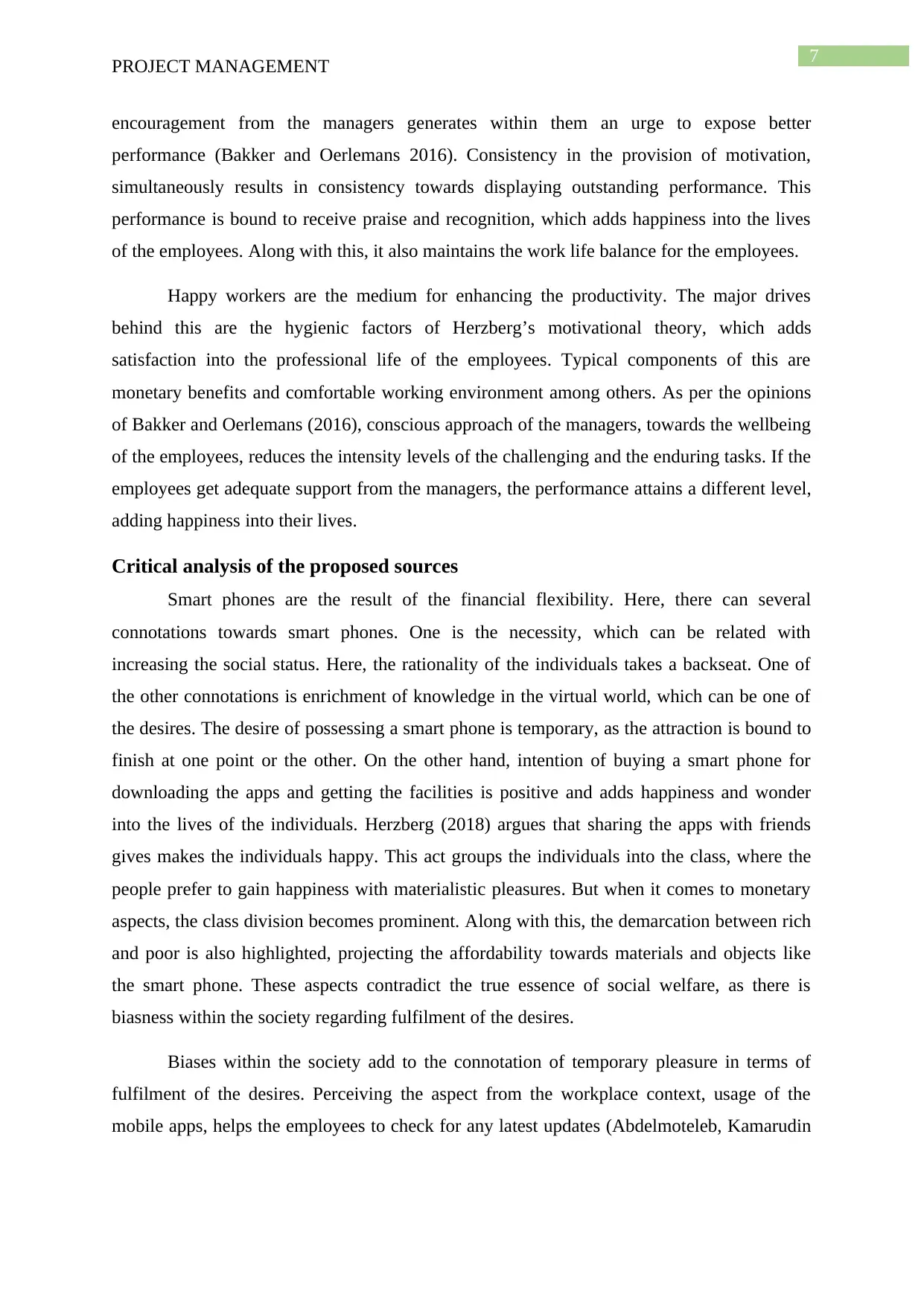
7
PROJECT MANAGEMENT
encouragement from the managers generates within them an urge to expose better
performance (Bakker and Oerlemans 2016). Consistency in the provision of motivation,
simultaneously results in consistency towards displaying outstanding performance. This
performance is bound to receive praise and recognition, which adds happiness into the lives
of the employees. Along with this, it also maintains the work life balance for the employees.
Happy workers are the medium for enhancing the productivity. The major drives
behind this are the hygienic factors of Herzberg’s motivational theory, which adds
satisfaction into the professional life of the employees. Typical components of this are
monetary benefits and comfortable working environment among others. As per the opinions
of Bakker and Oerlemans (2016), conscious approach of the managers, towards the wellbeing
of the employees, reduces the intensity levels of the challenging and the enduring tasks. If the
employees get adequate support from the managers, the performance attains a different level,
adding happiness into their lives.
Critical analysis of the proposed sources
Smart phones are the result of the financial flexibility. Here, there can several
connotations towards smart phones. One is the necessity, which can be related with
increasing the social status. Here, the rationality of the individuals takes a backseat. One of
the other connotations is enrichment of knowledge in the virtual world, which can be one of
the desires. The desire of possessing a smart phone is temporary, as the attraction is bound to
finish at one point or the other. On the other hand, intention of buying a smart phone for
downloading the apps and getting the facilities is positive and adds happiness and wonder
into the lives of the individuals. Herzberg (2018) argues that sharing the apps with friends
gives makes the individuals happy. This act groups the individuals into the class, where the
people prefer to gain happiness with materialistic pleasures. But when it comes to monetary
aspects, the class division becomes prominent. Along with this, the demarcation between rich
and poor is also highlighted, projecting the affordability towards materials and objects like
the smart phone. These aspects contradict the true essence of social welfare, as there is
biasness within the society regarding fulfilment of the desires.
Biases within the society add to the connotation of temporary pleasure in terms of
fulfilment of the desires. Perceiving the aspect from the workplace context, usage of the
mobile apps, helps the employees to check for any latest updates (Abdelmoteleb, Kamarudin
PROJECT MANAGEMENT
encouragement from the managers generates within them an urge to expose better
performance (Bakker and Oerlemans 2016). Consistency in the provision of motivation,
simultaneously results in consistency towards displaying outstanding performance. This
performance is bound to receive praise and recognition, which adds happiness into the lives
of the employees. Along with this, it also maintains the work life balance for the employees.
Happy workers are the medium for enhancing the productivity. The major drives
behind this are the hygienic factors of Herzberg’s motivational theory, which adds
satisfaction into the professional life of the employees. Typical components of this are
monetary benefits and comfortable working environment among others. As per the opinions
of Bakker and Oerlemans (2016), conscious approach of the managers, towards the wellbeing
of the employees, reduces the intensity levels of the challenging and the enduring tasks. If the
employees get adequate support from the managers, the performance attains a different level,
adding happiness into their lives.
Critical analysis of the proposed sources
Smart phones are the result of the financial flexibility. Here, there can several
connotations towards smart phones. One is the necessity, which can be related with
increasing the social status. Here, the rationality of the individuals takes a backseat. One of
the other connotations is enrichment of knowledge in the virtual world, which can be one of
the desires. The desire of possessing a smart phone is temporary, as the attraction is bound to
finish at one point or the other. On the other hand, intention of buying a smart phone for
downloading the apps and getting the facilities is positive and adds happiness and wonder
into the lives of the individuals. Herzberg (2018) argues that sharing the apps with friends
gives makes the individuals happy. This act groups the individuals into the class, where the
people prefer to gain happiness with materialistic pleasures. But when it comes to monetary
aspects, the class division becomes prominent. Along with this, the demarcation between rich
and poor is also highlighted, projecting the affordability towards materials and objects like
the smart phone. These aspects contradict the true essence of social welfare, as there is
biasness within the society regarding fulfilment of the desires.
Biases within the society add to the connotation of temporary pleasure in terms of
fulfilment of the desires. Perceiving the aspect from the workplace context, usage of the
mobile apps, helps the employees to check for any latest updates (Abdelmoteleb, Kamarudin
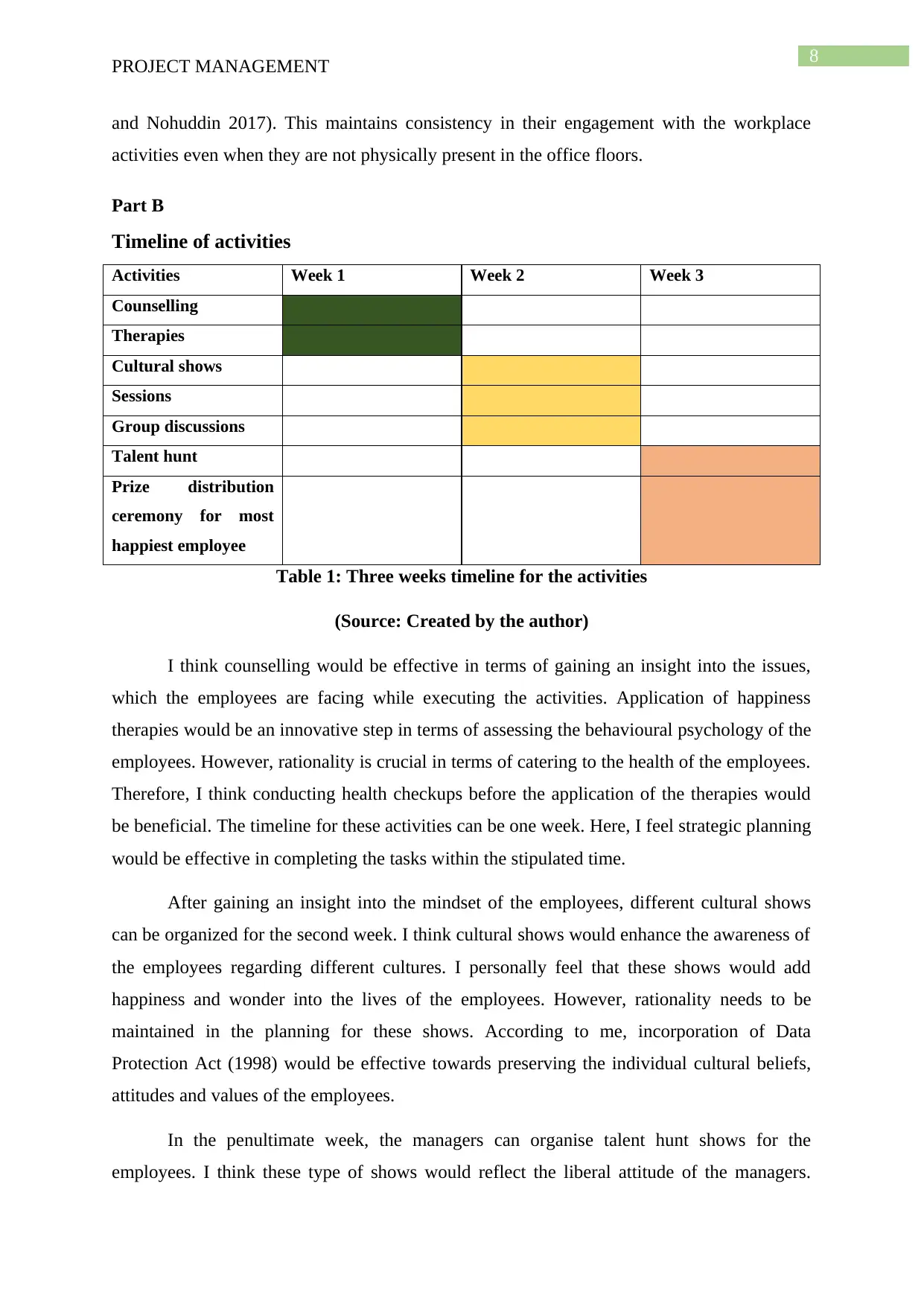
8
PROJECT MANAGEMENT
and Nohuddin 2017). This maintains consistency in their engagement with the workplace
activities even when they are not physically present in the office floors.
Part B
Timeline of activities
Activities Week 1 Week 2 Week 3
Counselling
Therapies
Cultural shows
Sessions
Group discussions
Talent hunt
Prize distribution
ceremony for most
happiest employee
Table 1: Three weeks timeline for the activities
(Source: Created by the author)
I think counselling would be effective in terms of gaining an insight into the issues,
which the employees are facing while executing the activities. Application of happiness
therapies would be an innovative step in terms of assessing the behavioural psychology of the
employees. However, rationality is crucial in terms of catering to the health of the employees.
Therefore, I think conducting health checkups before the application of the therapies would
be beneficial. The timeline for these activities can be one week. Here, I feel strategic planning
would be effective in completing the tasks within the stipulated time.
After gaining an insight into the mindset of the employees, different cultural shows
can be organized for the second week. I think cultural shows would enhance the awareness of
the employees regarding different cultures. I personally feel that these shows would add
happiness and wonder into the lives of the employees. However, rationality needs to be
maintained in the planning for these shows. According to me, incorporation of Data
Protection Act (1998) would be effective towards preserving the individual cultural beliefs,
attitudes and values of the employees.
In the penultimate week, the managers can organise talent hunt shows for the
employees. I think these type of shows would reflect the liberal attitude of the managers.
PROJECT MANAGEMENT
and Nohuddin 2017). This maintains consistency in their engagement with the workplace
activities even when they are not physically present in the office floors.
Part B
Timeline of activities
Activities Week 1 Week 2 Week 3
Counselling
Therapies
Cultural shows
Sessions
Group discussions
Talent hunt
Prize distribution
ceremony for most
happiest employee
Table 1: Three weeks timeline for the activities
(Source: Created by the author)
I think counselling would be effective in terms of gaining an insight into the issues,
which the employees are facing while executing the activities. Application of happiness
therapies would be an innovative step in terms of assessing the behavioural psychology of the
employees. However, rationality is crucial in terms of catering to the health of the employees.
Therefore, I think conducting health checkups before the application of the therapies would
be beneficial. The timeline for these activities can be one week. Here, I feel strategic planning
would be effective in completing the tasks within the stipulated time.
After gaining an insight into the mindset of the employees, different cultural shows
can be organized for the second week. I think cultural shows would enhance the awareness of
the employees regarding different cultures. I personally feel that these shows would add
happiness and wonder into the lives of the employees. However, rationality needs to be
maintained in the planning for these shows. According to me, incorporation of Data
Protection Act (1998) would be effective towards preserving the individual cultural beliefs,
attitudes and values of the employees.
In the penultimate week, the managers can organise talent hunt shows for the
employees. I think these type of shows would reflect the liberal attitude of the managers.
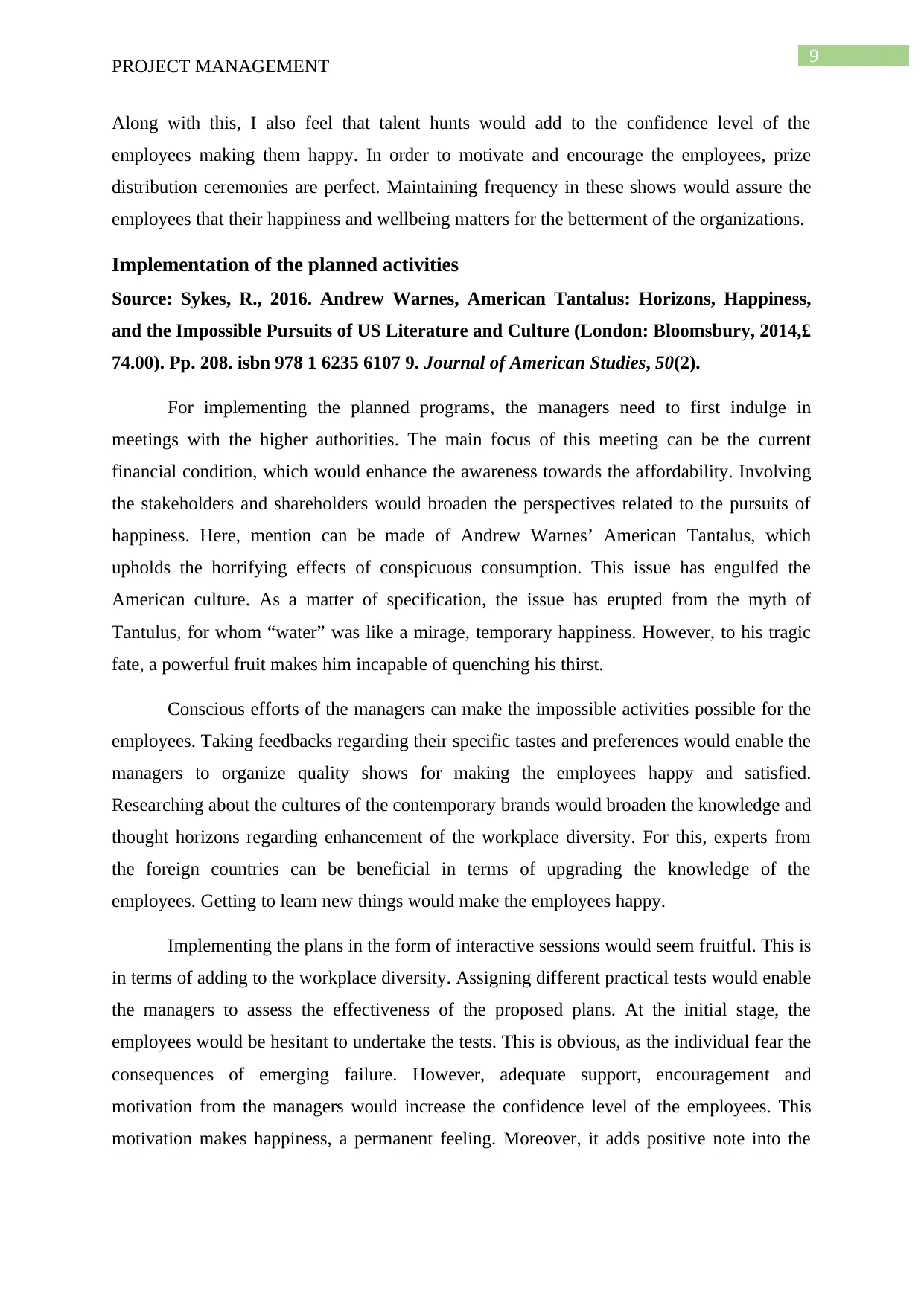
9
PROJECT MANAGEMENT
Along with this, I also feel that talent hunts would add to the confidence level of the
employees making them happy. In order to motivate and encourage the employees, prize
distribution ceremonies are perfect. Maintaining frequency in these shows would assure the
employees that their happiness and wellbeing matters for the betterment of the organizations.
Implementation of the planned activities
Source: Sykes, R., 2016. Andrew Warnes, American Tantalus: Horizons, Happiness,
and the Impossible Pursuits of US Literature and Culture (London: Bloomsbury, 2014,£
74.00). Pp. 208. isbn 978 1 6235 6107 9. Journal of American Studies, 50(2).
For implementing the planned programs, the managers need to first indulge in
meetings with the higher authorities. The main focus of this meeting can be the current
financial condition, which would enhance the awareness towards the affordability. Involving
the stakeholders and shareholders would broaden the perspectives related to the pursuits of
happiness. Here, mention can be made of Andrew Warnes’ American Tantalus, which
upholds the horrifying effects of conspicuous consumption. This issue has engulfed the
American culture. As a matter of specification, the issue has erupted from the myth of
Tantulus, for whom “water” was like a mirage, temporary happiness. However, to his tragic
fate, a powerful fruit makes him incapable of quenching his thirst.
Conscious efforts of the managers can make the impossible activities possible for the
employees. Taking feedbacks regarding their specific tastes and preferences would enable the
managers to organize quality shows for making the employees happy and satisfied.
Researching about the cultures of the contemporary brands would broaden the knowledge and
thought horizons regarding enhancement of the workplace diversity. For this, experts from
the foreign countries can be beneficial in terms of upgrading the knowledge of the
employees. Getting to learn new things would make the employees happy.
Implementing the plans in the form of interactive sessions would seem fruitful. This is
in terms of adding to the workplace diversity. Assigning different practical tests would enable
the managers to assess the effectiveness of the proposed plans. At the initial stage, the
employees would be hesitant to undertake the tests. This is obvious, as the individual fear the
consequences of emerging failure. However, adequate support, encouragement and
motivation from the managers would increase the confidence level of the employees. This
motivation makes happiness, a permanent feeling. Moreover, it adds positive note into the
PROJECT MANAGEMENT
Along with this, I also feel that talent hunts would add to the confidence level of the
employees making them happy. In order to motivate and encourage the employees, prize
distribution ceremonies are perfect. Maintaining frequency in these shows would assure the
employees that their happiness and wellbeing matters for the betterment of the organizations.
Implementation of the planned activities
Source: Sykes, R., 2016. Andrew Warnes, American Tantalus: Horizons, Happiness,
and the Impossible Pursuits of US Literature and Culture (London: Bloomsbury, 2014,£
74.00). Pp. 208. isbn 978 1 6235 6107 9. Journal of American Studies, 50(2).
For implementing the planned programs, the managers need to first indulge in
meetings with the higher authorities. The main focus of this meeting can be the current
financial condition, which would enhance the awareness towards the affordability. Involving
the stakeholders and shareholders would broaden the perspectives related to the pursuits of
happiness. Here, mention can be made of Andrew Warnes’ American Tantalus, which
upholds the horrifying effects of conspicuous consumption. This issue has engulfed the
American culture. As a matter of specification, the issue has erupted from the myth of
Tantulus, for whom “water” was like a mirage, temporary happiness. However, to his tragic
fate, a powerful fruit makes him incapable of quenching his thirst.
Conscious efforts of the managers can make the impossible activities possible for the
employees. Taking feedbacks regarding their specific tastes and preferences would enable the
managers to organize quality shows for making the employees happy and satisfied.
Researching about the cultures of the contemporary brands would broaden the knowledge and
thought horizons regarding enhancement of the workplace diversity. For this, experts from
the foreign countries can be beneficial in terms of upgrading the knowledge of the
employees. Getting to learn new things would make the employees happy.
Implementing the plans in the form of interactive sessions would seem fruitful. This is
in terms of adding to the workplace diversity. Assigning different practical tests would enable
the managers to assess the effectiveness of the proposed plans. At the initial stage, the
employees would be hesitant to undertake the tests. This is obvious, as the individual fear the
consequences of emerging failure. However, adequate support, encouragement and
motivation from the managers would increase the confidence level of the employees. This
motivation makes happiness, a permanent feeling. Moreover, it adds positive note into the
Secure Best Marks with AI Grader
Need help grading? Try our AI Grader for instant feedback on your assignments.
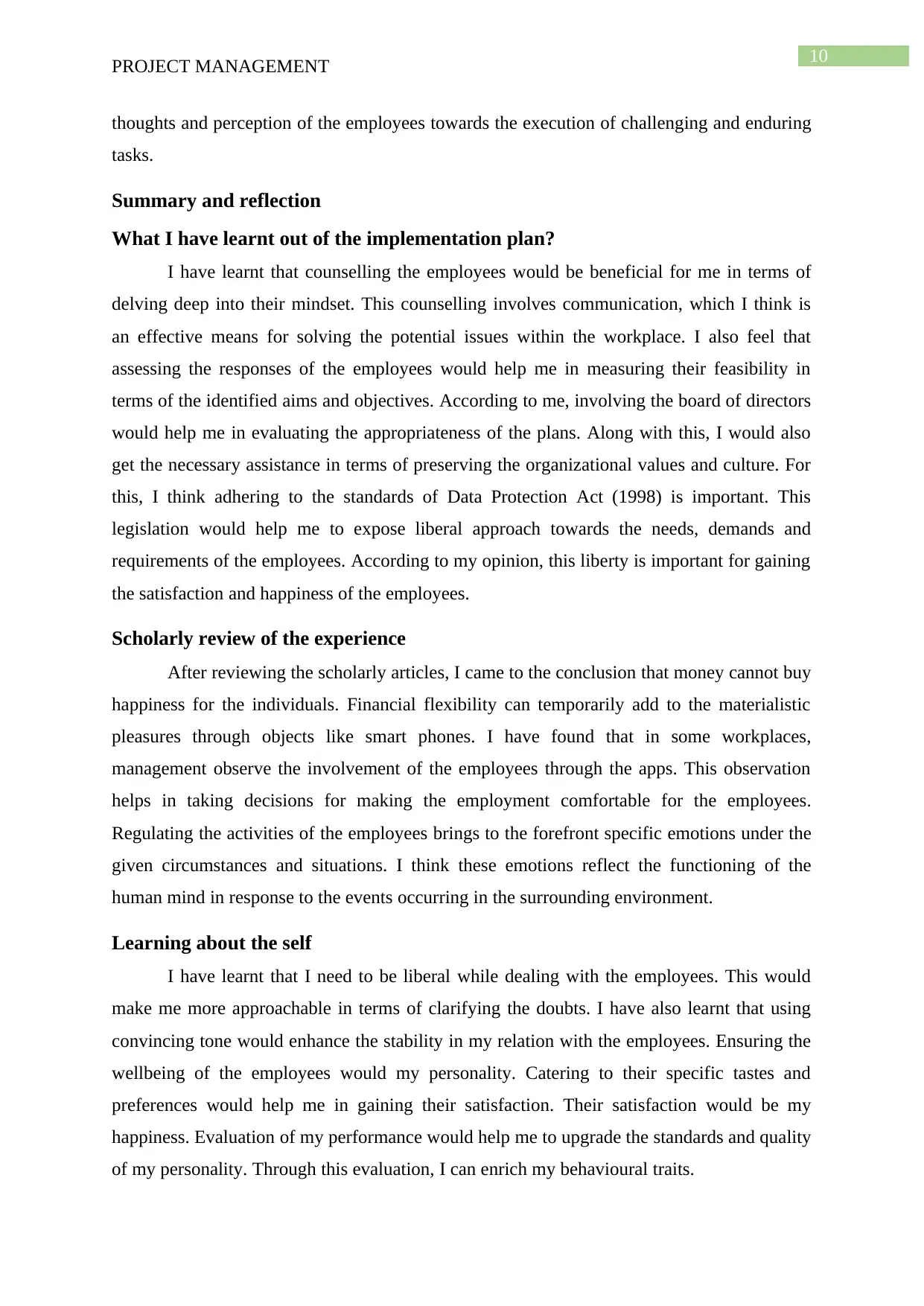
10
PROJECT MANAGEMENT
thoughts and perception of the employees towards the execution of challenging and enduring
tasks.
Summary and reflection
What I have learnt out of the implementation plan?
I have learnt that counselling the employees would be beneficial for me in terms of
delving deep into their mindset. This counselling involves communication, which I think is
an effective means for solving the potential issues within the workplace. I also feel that
assessing the responses of the employees would help me in measuring their feasibility in
terms of the identified aims and objectives. According to me, involving the board of directors
would help me in evaluating the appropriateness of the plans. Along with this, I would also
get the necessary assistance in terms of preserving the organizational values and culture. For
this, I think adhering to the standards of Data Protection Act (1998) is important. This
legislation would help me to expose liberal approach towards the needs, demands and
requirements of the employees. According to my opinion, this liberty is important for gaining
the satisfaction and happiness of the employees.
Scholarly review of the experience
After reviewing the scholarly articles, I came to the conclusion that money cannot buy
happiness for the individuals. Financial flexibility can temporarily add to the materialistic
pleasures through objects like smart phones. I have found that in some workplaces,
management observe the involvement of the employees through the apps. This observation
helps in taking decisions for making the employment comfortable for the employees.
Regulating the activities of the employees brings to the forefront specific emotions under the
given circumstances and situations. I think these emotions reflect the functioning of the
human mind in response to the events occurring in the surrounding environment.
Learning about the self
I have learnt that I need to be liberal while dealing with the employees. This would
make me more approachable in terms of clarifying the doubts. I have also learnt that using
convincing tone would enhance the stability in my relation with the employees. Ensuring the
wellbeing of the employees would my personality. Catering to their specific tastes and
preferences would help me in gaining their satisfaction. Their satisfaction would be my
happiness. Evaluation of my performance would help me to upgrade the standards and quality
of my personality. Through this evaluation, I can enrich my behavioural traits.
PROJECT MANAGEMENT
thoughts and perception of the employees towards the execution of challenging and enduring
tasks.
Summary and reflection
What I have learnt out of the implementation plan?
I have learnt that counselling the employees would be beneficial for me in terms of
delving deep into their mindset. This counselling involves communication, which I think is
an effective means for solving the potential issues within the workplace. I also feel that
assessing the responses of the employees would help me in measuring their feasibility in
terms of the identified aims and objectives. According to me, involving the board of directors
would help me in evaluating the appropriateness of the plans. Along with this, I would also
get the necessary assistance in terms of preserving the organizational values and culture. For
this, I think adhering to the standards of Data Protection Act (1998) is important. This
legislation would help me to expose liberal approach towards the needs, demands and
requirements of the employees. According to my opinion, this liberty is important for gaining
the satisfaction and happiness of the employees.
Scholarly review of the experience
After reviewing the scholarly articles, I came to the conclusion that money cannot buy
happiness for the individuals. Financial flexibility can temporarily add to the materialistic
pleasures through objects like smart phones. I have found that in some workplaces,
management observe the involvement of the employees through the apps. This observation
helps in taking decisions for making the employment comfortable for the employees.
Regulating the activities of the employees brings to the forefront specific emotions under the
given circumstances and situations. I think these emotions reflect the functioning of the
human mind in response to the events occurring in the surrounding environment.
Learning about the self
I have learnt that I need to be liberal while dealing with the employees. This would
make me more approachable in terms of clarifying the doubts. I have also learnt that using
convincing tone would enhance the stability in my relation with the employees. Ensuring the
wellbeing of the employees would my personality. Catering to their specific tastes and
preferences would help me in gaining their satisfaction. Their satisfaction would be my
happiness. Evaluation of my performance would help me to upgrade the standards and quality
of my personality. Through this evaluation, I can enrich my behavioural traits.
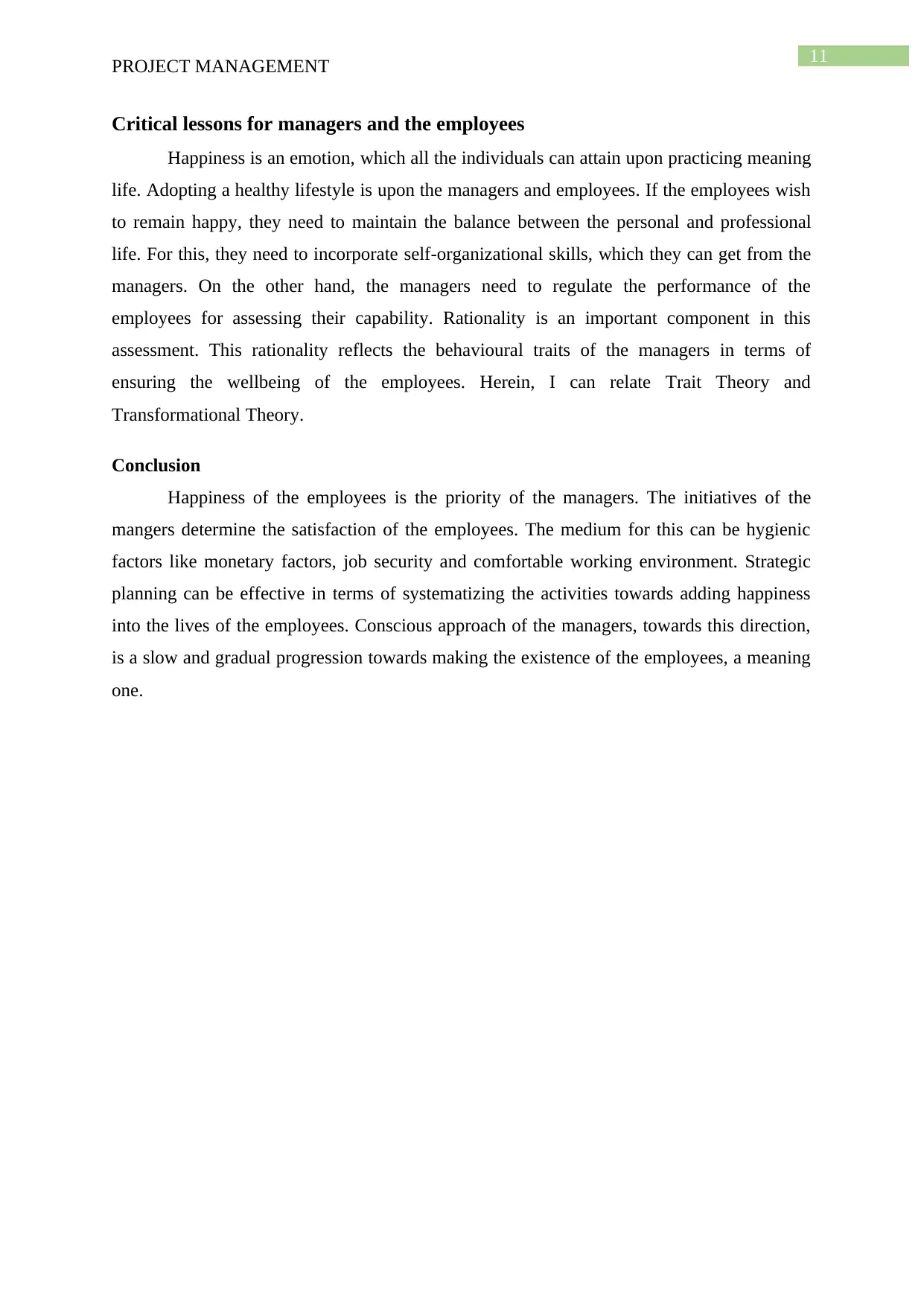
11
PROJECT MANAGEMENT
Critical lessons for managers and the employees
Happiness is an emotion, which all the individuals can attain upon practicing meaning
life. Adopting a healthy lifestyle is upon the managers and employees. If the employees wish
to remain happy, they need to maintain the balance between the personal and professional
life. For this, they need to incorporate self-organizational skills, which they can get from the
managers. On the other hand, the managers need to regulate the performance of the
employees for assessing their capability. Rationality is an important component in this
assessment. This rationality reflects the behavioural traits of the managers in terms of
ensuring the wellbeing of the employees. Herein, I can relate Trait Theory and
Transformational Theory.
Conclusion
Happiness of the employees is the priority of the managers. The initiatives of the
mangers determine the satisfaction of the employees. The medium for this can be hygienic
factors like monetary factors, job security and comfortable working environment. Strategic
planning can be effective in terms of systematizing the activities towards adding happiness
into the lives of the employees. Conscious approach of the managers, towards this direction,
is a slow and gradual progression towards making the existence of the employees, a meaning
one.
PROJECT MANAGEMENT
Critical lessons for managers and the employees
Happiness is an emotion, which all the individuals can attain upon practicing meaning
life. Adopting a healthy lifestyle is upon the managers and employees. If the employees wish
to remain happy, they need to maintain the balance between the personal and professional
life. For this, they need to incorporate self-organizational skills, which they can get from the
managers. On the other hand, the managers need to regulate the performance of the
employees for assessing their capability. Rationality is an important component in this
assessment. This rationality reflects the behavioural traits of the managers in terms of
ensuring the wellbeing of the employees. Herein, I can relate Trait Theory and
Transformational Theory.
Conclusion
Happiness of the employees is the priority of the managers. The initiatives of the
mangers determine the satisfaction of the employees. The medium for this can be hygienic
factors like monetary factors, job security and comfortable working environment. Strategic
planning can be effective in terms of systematizing the activities towards adding happiness
into the lives of the employees. Conscious approach of the managers, towards this direction,
is a slow and gradual progression towards making the existence of the employees, a meaning
one.
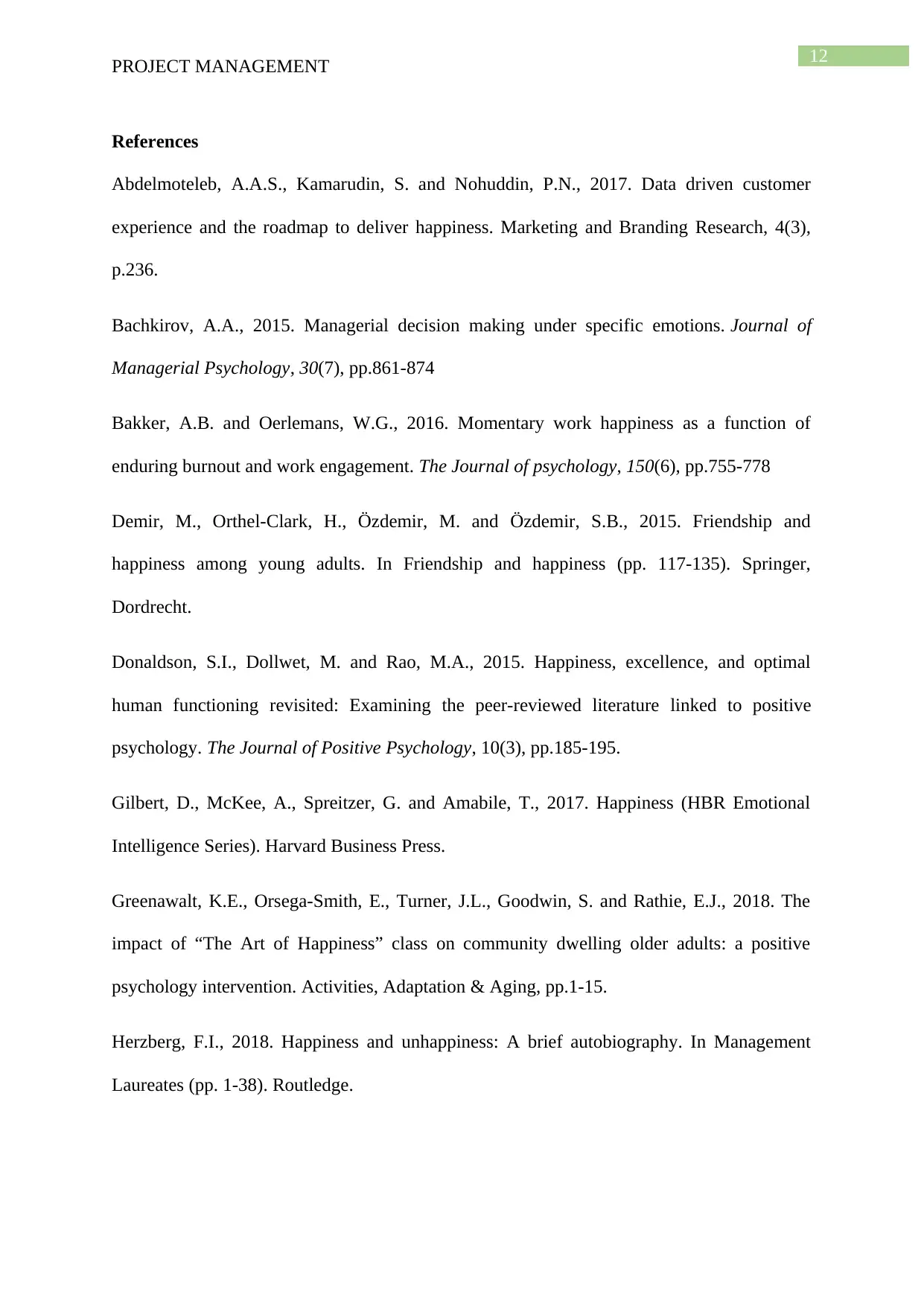
12
PROJECT MANAGEMENT
References
Abdelmoteleb, A.A.S., Kamarudin, S. and Nohuddin, P.N., 2017. Data driven customer
experience and the roadmap to deliver happiness. Marketing and Branding Research, 4(3),
p.236.
Bachkirov, A.A., 2015. Managerial decision making under specific emotions. Journal of
Managerial Psychology, 30(7), pp.861-874
Bakker, A.B. and Oerlemans, W.G., 2016. Momentary work happiness as a function of
enduring burnout and work engagement. The Journal of psychology, 150(6), pp.755-778
Demir, M., Orthel-Clark, H., Özdemir, M. and Özdemir, S.B., 2015. Friendship and
happiness among young adults. In Friendship and happiness (pp. 117-135). Springer,
Dordrecht.
Donaldson, S.I., Dollwet, M. and Rao, M.A., 2015. Happiness, excellence, and optimal
human functioning revisited: Examining the peer-reviewed literature linked to positive
psychology. The Journal of Positive Psychology, 10(3), pp.185-195.
Gilbert, D., McKee, A., Spreitzer, G. and Amabile, T., 2017. Happiness (HBR Emotional
Intelligence Series). Harvard Business Press.
Greenawalt, K.E., Orsega-Smith, E., Turner, J.L., Goodwin, S. and Rathie, E.J., 2018. The
impact of “The Art of Happiness” class on community dwelling older adults: a positive
psychology intervention. Activities, Adaptation & Aging, pp.1-15.
Herzberg, F.I., 2018. Happiness and unhappiness: A brief autobiography. In Management
Laureates (pp. 1-38). Routledge.
PROJECT MANAGEMENT
References
Abdelmoteleb, A.A.S., Kamarudin, S. and Nohuddin, P.N., 2017. Data driven customer
experience and the roadmap to deliver happiness. Marketing and Branding Research, 4(3),
p.236.
Bachkirov, A.A., 2015. Managerial decision making under specific emotions. Journal of
Managerial Psychology, 30(7), pp.861-874
Bakker, A.B. and Oerlemans, W.G., 2016. Momentary work happiness as a function of
enduring burnout and work engagement. The Journal of psychology, 150(6), pp.755-778
Demir, M., Orthel-Clark, H., Özdemir, M. and Özdemir, S.B., 2015. Friendship and
happiness among young adults. In Friendship and happiness (pp. 117-135). Springer,
Dordrecht.
Donaldson, S.I., Dollwet, M. and Rao, M.A., 2015. Happiness, excellence, and optimal
human functioning revisited: Examining the peer-reviewed literature linked to positive
psychology. The Journal of Positive Psychology, 10(3), pp.185-195.
Gilbert, D., McKee, A., Spreitzer, G. and Amabile, T., 2017. Happiness (HBR Emotional
Intelligence Series). Harvard Business Press.
Greenawalt, K.E., Orsega-Smith, E., Turner, J.L., Goodwin, S. and Rathie, E.J., 2018. The
impact of “The Art of Happiness” class on community dwelling older adults: a positive
psychology intervention. Activities, Adaptation & Aging, pp.1-15.
Herzberg, F.I., 2018. Happiness and unhappiness: A brief autobiography. In Management
Laureates (pp. 1-38). Routledge.
Paraphrase This Document
Need a fresh take? Get an instant paraphrase of this document with our AI Paraphraser
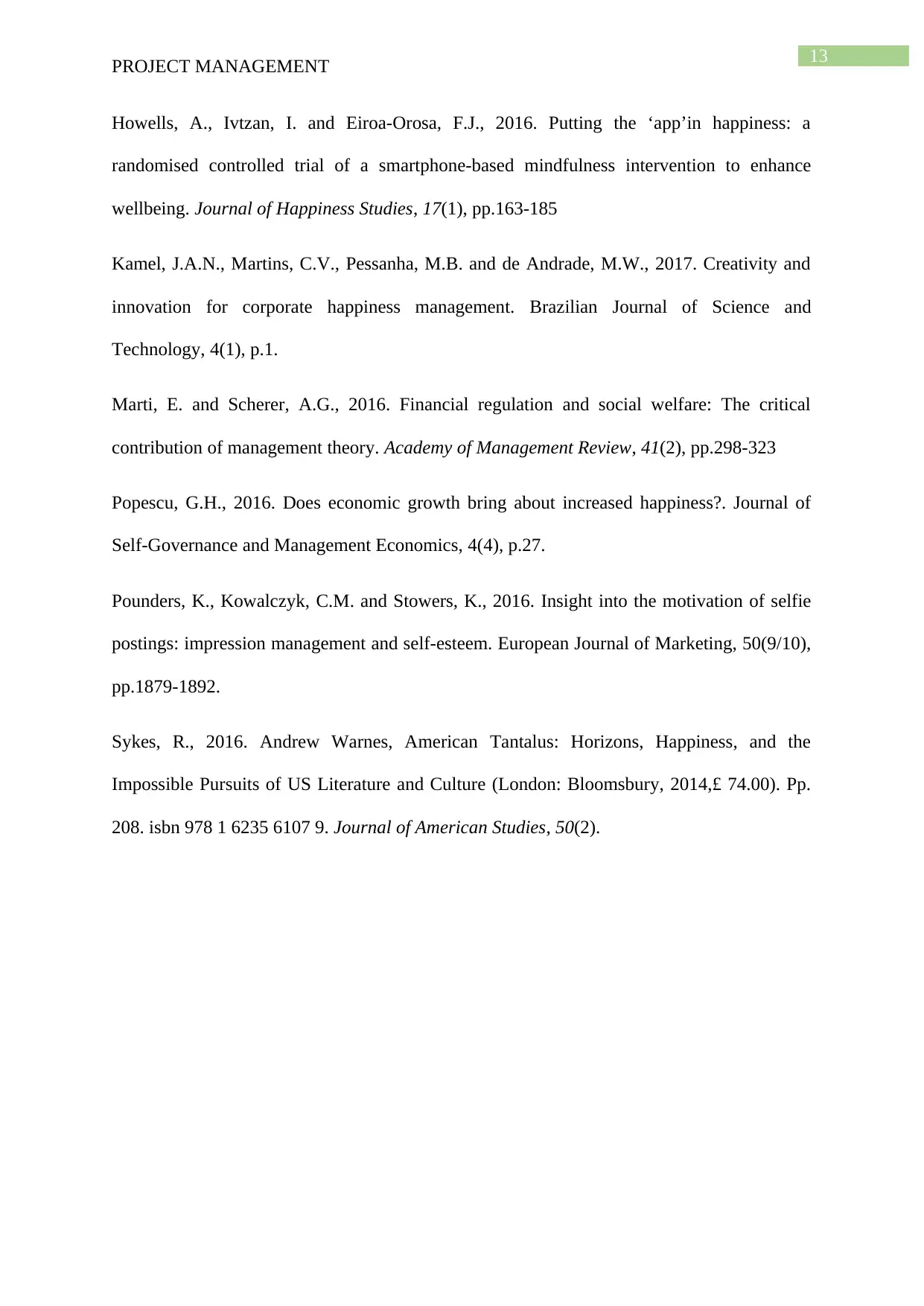
13
PROJECT MANAGEMENT
Howells, A., Ivtzan, I. and Eiroa-Orosa, F.J., 2016. Putting the ‘app’in happiness: a
randomised controlled trial of a smartphone-based mindfulness intervention to enhance
wellbeing. Journal of Happiness Studies, 17(1), pp.163-185
Kamel, J.A.N., Martins, C.V., Pessanha, M.B. and de Andrade, M.W., 2017. Creativity and
innovation for corporate happiness management. Brazilian Journal of Science and
Technology, 4(1), p.1.
Marti, E. and Scherer, A.G., 2016. Financial regulation and social welfare: The critical
contribution of management theory. Academy of Management Review, 41(2), pp.298-323
Popescu, G.H., 2016. Does economic growth bring about increased happiness?. Journal of
Self-Governance and Management Economics, 4(4), p.27.
Pounders, K., Kowalczyk, C.M. and Stowers, K., 2016. Insight into the motivation of selfie
postings: impression management and self-esteem. European Journal of Marketing, 50(9/10),
pp.1879-1892.
Sykes, R., 2016. Andrew Warnes, American Tantalus: Horizons, Happiness, and the
Impossible Pursuits of US Literature and Culture (London: Bloomsbury, 2014,£ 74.00). Pp.
208. isbn 978 1 6235 6107 9. Journal of American Studies, 50(2).
PROJECT MANAGEMENT
Howells, A., Ivtzan, I. and Eiroa-Orosa, F.J., 2016. Putting the ‘app’in happiness: a
randomised controlled trial of a smartphone-based mindfulness intervention to enhance
wellbeing. Journal of Happiness Studies, 17(1), pp.163-185
Kamel, J.A.N., Martins, C.V., Pessanha, M.B. and de Andrade, M.W., 2017. Creativity and
innovation for corporate happiness management. Brazilian Journal of Science and
Technology, 4(1), p.1.
Marti, E. and Scherer, A.G., 2016. Financial regulation and social welfare: The critical
contribution of management theory. Academy of Management Review, 41(2), pp.298-323
Popescu, G.H., 2016. Does economic growth bring about increased happiness?. Journal of
Self-Governance and Management Economics, 4(4), p.27.
Pounders, K., Kowalczyk, C.M. and Stowers, K., 2016. Insight into the motivation of selfie
postings: impression management and self-esteem. European Journal of Marketing, 50(9/10),
pp.1879-1892.
Sykes, R., 2016. Andrew Warnes, American Tantalus: Horizons, Happiness, and the
Impossible Pursuits of US Literature and Culture (London: Bloomsbury, 2014,£ 74.00). Pp.
208. isbn 978 1 6235 6107 9. Journal of American Studies, 50(2).
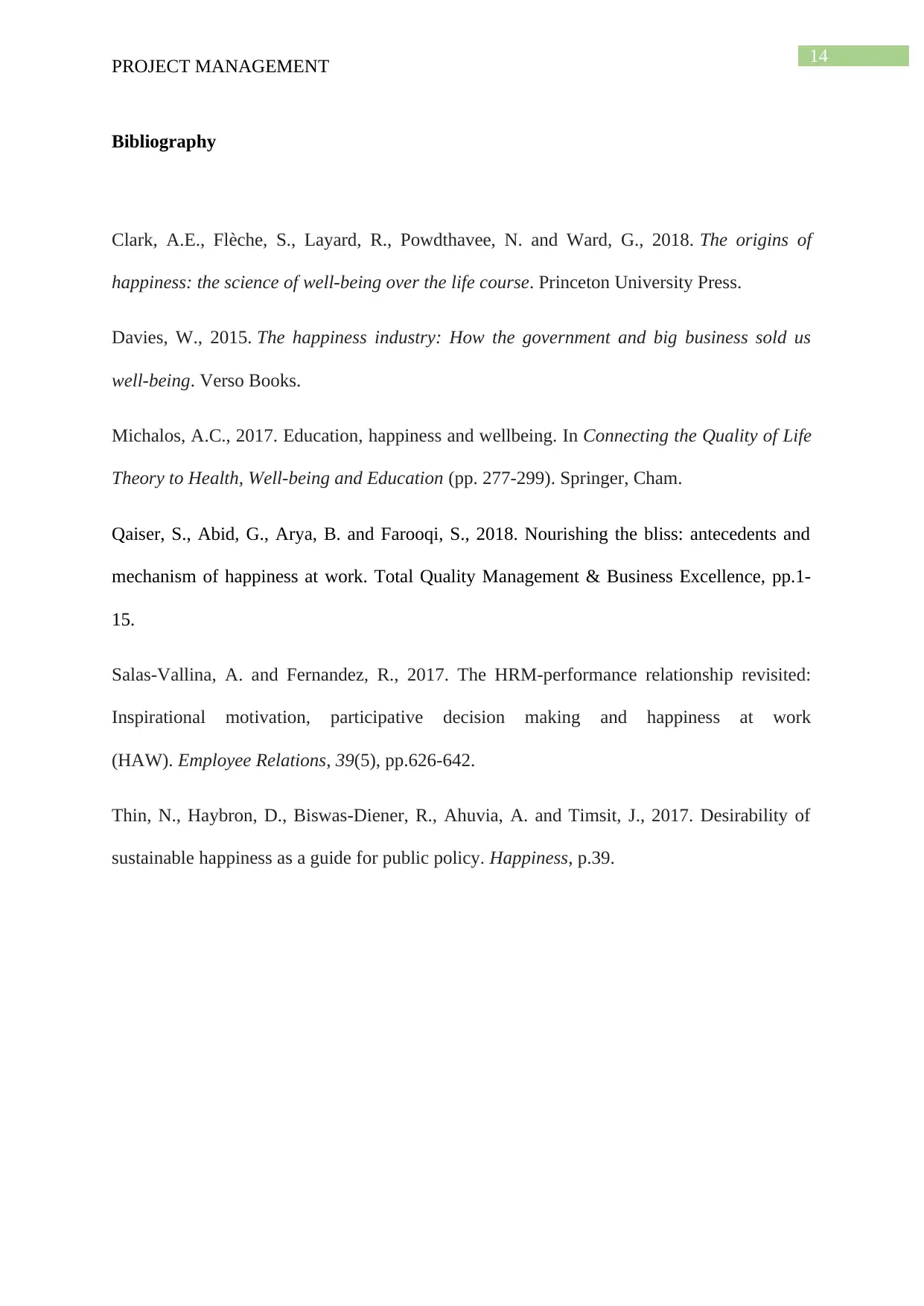
14
PROJECT MANAGEMENT
Bibliography
Clark, A.E., Flèche, S., Layard, R., Powdthavee, N. and Ward, G., 2018. The origins of
happiness: the science of well-being over the life course. Princeton University Press.
Davies, W., 2015. The happiness industry: How the government and big business sold us
well-being. Verso Books.
Michalos, A.C., 2017. Education, happiness and wellbeing. In Connecting the Quality of Life
Theory to Health, Well-being and Education (pp. 277-299). Springer, Cham.
Qaiser, S., Abid, G., Arya, B. and Farooqi, S., 2018. Nourishing the bliss: antecedents and
mechanism of happiness at work. Total Quality Management & Business Excellence, pp.1-
15.
Salas-Vallina, A. and Fernandez, R., 2017. The HRM-performance relationship revisited:
Inspirational motivation, participative decision making and happiness at work
(HAW). Employee Relations, 39(5), pp.626-642.
Thin, N., Haybron, D., Biswas-Diener, R., Ahuvia, A. and Timsit, J., 2017. Desirability of
sustainable happiness as a guide for public policy. Happiness, p.39.
PROJECT MANAGEMENT
Bibliography
Clark, A.E., Flèche, S., Layard, R., Powdthavee, N. and Ward, G., 2018. The origins of
happiness: the science of well-being over the life course. Princeton University Press.
Davies, W., 2015. The happiness industry: How the government and big business sold us
well-being. Verso Books.
Michalos, A.C., 2017. Education, happiness and wellbeing. In Connecting the Quality of Life
Theory to Health, Well-being and Education (pp. 277-299). Springer, Cham.
Qaiser, S., Abid, G., Arya, B. and Farooqi, S., 2018. Nourishing the bliss: antecedents and
mechanism of happiness at work. Total Quality Management & Business Excellence, pp.1-
15.
Salas-Vallina, A. and Fernandez, R., 2017. The HRM-performance relationship revisited:
Inspirational motivation, participative decision making and happiness at work
(HAW). Employee Relations, 39(5), pp.626-642.
Thin, N., Haybron, D., Biswas-Diener, R., Ahuvia, A. and Timsit, J., 2017. Desirability of
sustainable happiness as a guide for public policy. Happiness, p.39.
1 out of 15
Your All-in-One AI-Powered Toolkit for Academic Success.
+13062052269
info@desklib.com
Available 24*7 on WhatsApp / Email
![[object Object]](/_next/static/media/star-bottom.7253800d.svg)
Unlock your academic potential
© 2024 | Zucol Services PVT LTD | All rights reserved.
